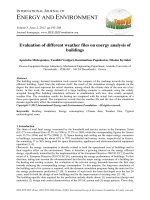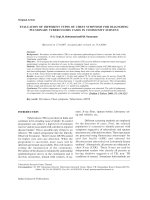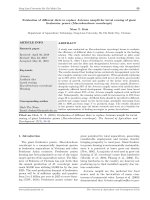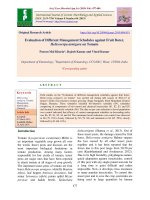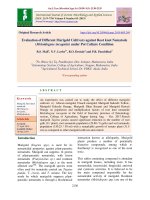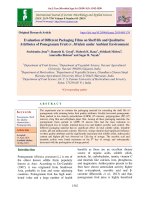Evaluation of different management schedules against fruit borer, Helicoverpa Armigera on tomato
Bạn đang xem bản rút gọn của tài liệu. Xem và tải ngay bản đầy đủ của tài liệu tại đây (224.25 KB, 8 trang )
Int.J.Curr.Microbiol.App.Sci (2019) 8(4): 477-484
International Journal of Current Microbiology and Applied Sciences
ISSN: 2319-7706 Volume 8 Number 04 (2019)
Journal homepage:
Original Research Article
/>
Evaluation of Different Management Schedules against Fruit Borer,
Helicoverpa armigera on Tomato
Pooran Mal Kharia*, Rajesh Kumar and Vinod Kumar
Department of Entomology, 3Department of Nematology, CCS HAU, Hisar, 125004, India
*Corresponding author
ABSTRACT
Keywords
Helicoverpa
armigera, Tomato,
Management,
Nimbecidine,
Chemical
Article Info
Accepted:
07 March 2019
Available Online:
10 April 2019
Field studies on the “Evaluation of different management schedules against fruit borer,
Helicoverpa armigera on tomato" was carried out during rabi season of 2014-15 at
farmer’s field of an extensive tomato growing village Surajgarh, block Matanhail, District
Jhajjar, Haryana. These schedules included bio-intensive schedule (S4), schedules
comprising of components of bio-control and chemical insecticides (S1, S2, S3, and S5)
and chemical insecticide schedule (S6). The data on per cent reduction in larval population
over control indicated that efficacy of various management schedules in descending order
was S6, S5, S1, S2, S3 and S4. The maximum larval reduction over control was observed
in S6 (79. 91%) closely followed by S5 (79. 04) and minimum in S4 (65. 50%) closely
followed by S3 (66. 81%).
dedecastigma (Sharma et al., 2013). Out of
these insect pests, the damage caused by fruit
borer, Helicoverpa armigera Hubner surpass
the loss caused by all other insect pests
together and it has been reported that the
losses due to this pest range from 20-50 per
cent (Karabhantanal and Awaknavar, 2012).
Due to its high fecundity, polyphagous nature,
quick adaptation against insecticides, control
of this pest with any single potent toxicant for
a long time is quiet difficult and rather
impossible. Now, it develops cross resistance
to many popular insecticides. To control this
insect pest and to save the crop, pesticides are
being used in large quantities by human
Introduction
Tomato (Lycopersicon esculentum) Miller is
an important vegetable crop grown all over
the world. Insect pests and diseases are the
most important biological limitations in
tomato production. Among many factors
responsible for low yields of tomato, insect
pests are major ones that have been reported
to attack tomato at all stages of crop growth.
The important insect pests of tomato are fruit
borer Helicoverpa armigera, whitefly Bemisia
tabaci, leaf hopper Amrasca devastans, leaf
miner Liriomyza trifolii, potato aphid Myzus
persicae and hadda beetle, Epilachana
477
Int.J.Curr.Microbiol.App.Sci (2019) 8(4): 477-484
being. But the continuous and enormous use
of same or similar groups of pesticides causes
problem of pesticide residues.
including untreated (control), one day before
each spray and at 3, 5, and 7 days after
completion of the schedule using drop sheet
method.
However, sometimes there has been complete
destruction of tomato crop by this pest (Fery
and Cuthbert, 1974). In spite of regular
spraying of insecticides, its incidence in
farmers’ fields varies from 10 to 20 per cent
and at times, this pest causes yield loss up to
40 per cent (Tiwari and Krishnamoorthy,
1984). With the introduction of new
molecules, farmers use a variety of chemical
insecticidal sprays in a haphazard manner for
management of insect-pests of tomato. This
leads to high cost on protection measures with
poor insect-pest management. To reduce the
ill effects of conventional chemical
insecticides, there is great need to evaluate
different management schedules based on
combination of bio-rational and eco-friendly
pesticides, alone and in combination.
Statistical analysis of data
The obtained data were statistically analysed
using
angular
transformation
and
square root transformation.
Results and Discussion
The results of the experiment entitled
“Evaluation of different management
schedules against fruit borer, Helicoverpa
armigera on tomato” undertaken at farmer’s
field of an extensive tomato growing village
Surajgarh, block Matanhail, District Jhajjar,
Haryana, have been presented along with
discussion on the experimental finding in the
light of scientific reasoning and their
conformity with the previous researchers.
Different management schedules had been
evaluated against H. armigera. These
schedules included bio-intensive schedule
(S4), schedules comprising of components of
bio-control and chemical insecticides (S1, S2,
S3 and S5) and chemical insecticide schedule
(S6). On the basis of studies on effects of first
management practice/spray after 10 days in
different schedules, it is evident that spray of
Nimbecidine 300 ppm @ 2.5 l/ha (S1, S2, S5)
or two releases of Trichogramma chilonis @
50000 prasitoids eggs /ha (S3, S4) did not
reduce the larval population on tomato. The
larval reduction was observed only in S6 i.e.
Fenvalerate 20EC @ 188 ml/ha (Table 2)
which is well supported by the findings of
Mishra (1984); Setiawati (1990) and
Walgenbach and Estes (1992). Nimbecidine
300 ppm+ Novaluron 10EC @ 188 ml/ha
(both in S1 and S2) reduced larval population
10 days after application as second
management practice/spray but reduction was
still highest (18.10%) in S6 when crop was
Materials and Methods
A field trial was laid out in village Surajgarh,
block Matanhail, District Jhajjar, Haryana
during Kharif 2014-15 on tomato, cv.
Abhinav in randomised block design with
seven treatments (six and untreated control) in
three repeats and the plot size 6×3 m2 and
spacing 60x45 cm. Different management
schedules (Table 1) were evaluated with
following specifications: One row of African
yellow marigold was alternated after five
rows of tomato at the time of transplanting.
For this purpose, the nursery of marigold was
raised one month in advance of tomato so that
there was synchronization of flowering on
them in the field. One Yellow sticky trap per
replications was installed after establishment
of plants.
Observations on larval population of H.
armigera were recorded per 3 leaves on 5
randomly selected plants in each schedule
478
Int.J.Curr.Microbiol.App.Sci (2019) 8(4): 477-484
sprayed with Malathion 50 EC @1.0 l/ha
(Table 3). Mathur et al., (1974) also found
Malathion to give effective suppression of H.
armigera.
500 ml/ha and Spinosad 45 SC @ 188 ml/ha)
and bio- intensive schedule proved least
effective.
After complection of all schedules, their
efficacy was studied in detail by recording
observations on larval population of
H.armigera after 3,5,7 and 10 days of last
spray (Table 6).
Spinosad 45 SC @ 188 ml/ha proved most
effective in reducing larval population
(27.48), in S3 closely followed by B.t.k. @
1.0l/ha (27.37%) in S5 when used as 3rd
management practice/spray (Table 4). These
findings are in agreement with the
observations recorded by Ghos et al., (2010),
Lutwama and Matammi (1988), Praveen et
al., (2001) and Prasad et al., (2003). When
larval population was recorded ten days after
4th management practice/spray (Table 5),
highest larval reduction (29.23%) was
observed in S1 where Spinosad 45 SC @ 188
ml/ha was sprayed, closely followed by S2
(Novaluron 10EC @ 37 5ml/ha). Nimbecidine
300 ppm @ 2.5 l/ha proved least effective (S3
and S4) in reducing larval population at this
stage which is in concurrence with the
findings of Mathur et al., (1996). Ten days
after 5th management practice/spray, in
addition to the efficacy of various schedules
there was also natural reduction in the larval
population of fruit borer in all the schedules
including control (32.97 to 60.33%) but
population was still above ETL in control
(2.29 larvae/plant).
At each observation, chemical insecticide
schedule i.e S6 (Fenvalerate 20 EC @ 188
ml/ha followed by Malathion 50 EC @ 1.0
l/ha, Decamethrin 2.8 EC @ 500 ml/ha,
Malathion 50 EC @ 1.0 l/ha and
Cypermethrin 25 EC @ 150 ml/ha) was found
most effective with lowest larval population
and was at par with S5 (Nimbecidine 300
ppm @ 2.5 l/ha followed by Malathion 50 EC
@ 1.0 l/ha, B.t.k. @ 1.0 kg/ha, Decamethrin
2.8 EC @ 500 ml/ha and Spinosad 45 SC @
188 ml/ha) while bio-intensive schedule i.e S4
(African yellow marigold + Yellow sticky
trap + T. chilonis @ 50000 parasitised eggs/ha
(Two releases at 4 days interval) followed by
Nimbecidine 300 ppm @ 2.5 l/ha, B.t.k.@ 1.0
kg/ha, Nimbecidine 300 ppm @ 2.5 l/ha and
Bt formulation (Delfin) @ 1.0 kg/ha) was
found least effective having highest larval
population.
The schedule S1 (Nimbecidine 300 ppm @
2.5 l/ha followed by Nimbecidine 300 ppm @
1.25 l/ha + Novaluron 10 EC @ 188 ml/ha, Bt
formulation (Delfin) @ 1.0 kg/ha, Spinosad
45 SC @ 188 ml/ha and Novaluron 10 EC @
375 ml/ha ) and S2 (Nimbecidine 300 ppm @
2.5 l/ha followed by Nimbecidine 300 ppm @
1.25 l/ha + Novaluron 10 EC @ 188ml/ha,
B.t.k.@ 1.0 kg/ha, Novaluron 10 EC @ 375
ml/ha and Novaluron 10 EC @ 375 ml/ha)
were at par throughout the obseravation
period, however these were at par with S6 and
S5 up to 3 days after completion of schedules
but lost their efficacy thereafter and occupied
a place between two extremes.
Based on the data on average larval
population of each schedule (Table 6), it is
inferred that all the management schedules
were superior than untreated control and
chemical insecticide based schedule i.e S6
(Fenvalerate 20 EC @ 188 ml/ha followed by
Malathion 50 EC @ 1.0 l/ha, Decamethrin 2.8
EC @ 500 ml/ha, Malathion 50 EC @ 1.0 l/ha
and Cypermethrin 25 EC @ 150 ml/ha)
proved most effective in reducing larval
population by 20.35 per cent followed by
schedule S5 (Nimbecidine 300 ppm @ 2.5
l/ha followed by Malathion 50 EC @ 1.0 l/ha,
B.t.k. @ 1.0 kg/ha, Decamethrin 2.8 EC @
479
Int.J.Curr.Microbiol.App.Sci (2019) 8(4): 477-484
Table.1 Management schedules evaluated against tomato fruit borer, Helicoverpa armigera on tomato
Schedule
2 management
practice/spray
S1
Spray of Nimbecidine 300
ppm @ 2.5 l/ha
Spray of B.t.k.@ 1.0 kg/ha
Spray of Spinosad
45 SC @ 188 ml/ha
Spray of Novaluron
10 EC @ 375 ml/ha
S2
Spray of Nimbecidine 300
ppm @ 2.5 l/ha
Spray of B.t.k.@ 1.0 kg/ha
Spray of Novaluron
10 EC @ 375 ml/ha
Spray of Novaluron
10 EC @ 375 ml/ha
S3
Trichogramma chilonis Ishi
@ 50000 parasitised eggs/ha
(2 releases at 4 days
interval)
African yellow marigold*+
Yellow sticky trap**+
Trichogramma chilonis Ishi
@ 50000 parasitised eggs/ha
(2 releases at 4 days
interval)
Spray of Nimbecidine 300
ppm @ 2.5 l/ha
Mixed Spray of Nimbecidine
300 ppm @ 1.25 l/ha
+Novaluron 10 EC @ 188
ml/ha)
Mixed Spray of Nimbecidine
300 ppm @ 1.25 l/ha
+Novaluron 10 EC @ 188
ml/ha)
Spray of Nimbecidine 300
ppm @ 2.5 l/ha
Spray of Spinosad 45 SC
@ 188 ml/ha
Spray of
Nimbecidine 300
ppm @ 2.5 l/ha
Spray of Novaluron
10 EC @ 375 ml/ha
Spray of Nimbecidine 300
ppm @ 2.5 l/ha
Spray of B.t.k.@ 1.0 kg/ha
Spray of
Nimbecidine 300
ppm @ 2.5 l/ha
Spray of B.t.k.@ 1.0
kg/ha
Spray of Malathion 50 EC @
1.0 l/ha
Spray of B.t.k.@ 1.0 kg/ha
Spray of Spinosad 45
SC @ 188 ml/ha
1 management
practice/spray
S4
nd
Management practice/spray
3rd management
practice/spray
st
4th management
practice/spray
S6
Spray of Fenvalerate 20 EC
@ 188 ml/ha
Spray of Malathion 50 EC @
1.0 l/ha
Spray of Decamethrin 2.8
EC @ 500 ml ha
Spray of
Decamethrin 2.8
EC @ 500 ml ha
Spray of Malathion
50 EC @ 1.0 l/ha
S7
Untreated (control)
Untreated (control)
Untreated (control)
Untreated (control)
S5
480
5th management
practice/spray
Spray of
Cypermethrin 25 EC
@ 150 ml/ha
Untreated (control)
Int.J.Curr.Microbiol.App.Sci (2019) 8(4): 477-484
Table.2 Effect of management schedules after 1st management practice/spray on the population
of fruit borer, Helicoverpa armigera on tomato
Schedule
(S)
1st management practice/spray
S1
Spray of Nimbecidine 300 ppm @ 2.5 l/ha
S2
Spray of Nimbecidine 300 ppm @ 2.5 l/ha
S3
S5
Trichogramma chilonis Ishi @ 50000 parasitised
eggs/ha (2 releases at 4 days interval)
African yellow marigold*+ Yellow sticky trap**+
Trichogramma chilonis Ishi @ 50000 parasitised
eggs/ha (2 releases at 4 days interval)
Spray of Nimbecidine 300 ppm @ 2.5 l/ha
S6
Spray of Fenvalerate 20 EC @ 188 ml/ha
S7
Untreated (control)
S4
SE (m)
C.D. (p=0.05)
Figures in parentheses are square root transformation (
Figures with same letter are non significant
No. of larvae/plant
(average of 5 plants)
1 day
10 days
Reduction
before
after spray
(%)
spray
1.43
1.90
-33.41
(1.55)
(1.70)b
1.40
1.87
-33.33
(1.52)
(1.69)b
1.28
2.08
-62.66
(1.48)
(1.75)c
1.20
2.10
-75.00
(1.47)
(1.76)c
1.33
(1.48)
1.53
(1.54)
1.45
(1.55)
0.22
NS
1.81
(1.68)b
1.16
(1.47)a
2.25
(1.80)d
0.01
0.03
-36.09
24.35
-55.17
) values
Table.3 Effect of management schedules after 2nd management practice/spray on the population
of fruit borer, Helicoverpa armigera on tomato
Schedule
(S)
2nd management practice/spray
S3
Mixed Spray of Nimbecidine 300 ppm @ 1.25
l/ha +Novaluron 10 EC @ 188 ml/ha)
Mixed Spray of Nimbecidine 300 ppm @ 1.25
l/ha +Novaluron 10 EC @ 188 ml/ha)
Spray of Nimbecidine 300 ppm @ 2.5 l/ha
S4
Spray of Nimbecidine 300 ppm @ 2.5 l/ha
S5
Spray of Malathion 50 EC @ 1.0 l/ha
S6
Spray of Malathion 50 EC @ 1.0 l/ha
S7
Untreated (control)
S1
S2
SE (m)
C.D. (p=0.05)
Figures in parentheses are square root transformation (
Figures with same letter are non significant
No. of larvae/plant
(average of 5 plants)
1 day before
10 days
Reduction
spray
after spray
(%)
1.90
1.75
8.06
(1.70)b
(1.65)c
1.87
1.69
9.46
(1.69)b
(1.64)c
2.08
2.62
-26.16
(1.75)c
(1.90)d
2.10
2.51
-19.52
(1.76)c
(1.87)d
1.81
1.55
14.36
(1.68)b
(1.60)b
1.16
0.95
18.10
(1.47)a
(1.40)a
2.25
2.96
-31.56
(1.80)d
(2.00)e
0.01
0.01
0.03
0.03
) values
481
Int.J.Curr.Microbiol.App.Sci (2019) 8(4): 477-484
Table.4 Effect of management schedules after 3rd management practice/spray on the population
of fruit borer, Helicoverpa armigera on tomato
Schedule
(S)
S1
3rd management practice/spray
S2
Spray of B.t.k.@ 1.0 kg/ha
S3
S4
Spray of Spinosad 45 SC @ 188
ml/ha
Spray of B.t.k.@ 1.0 kg/ha
S5
Spray of B.t.k.@ 1.0 kg/ha
S6
Spray of Decamethrin 2.8 EC @
500 ml ha
Untreated (control)
S7
Spray of B.t.k.@ 1.0 kg/ha
SE (m)
C.D. (p=0.05)
No. of larvae/plant (average of 5 plants)
1 day before spray 10 days after
Reduction (%)
spray
1.75
1.30
25.86
(1.65)c
(1.52)c
1.69
1.26
25.49
(1.64)c
(1.50)c
2.62
1.95
27.48
(1.90)d
(1.70)d
2.51
2.06
17.95
(1.87)d
(1.75)d
1.55
1.12
27.37
(1.60)b
(1.46)b
0.95
0.89
5.96
(1.40)a
(1.38)a
2.96
3.77
-27.48
(2.00)e
(2.18)e
0.01
0.01
0.03
0.04
Figures in parentheses are square root transformation (
Figures with same letter are non-significant
) values
Table.5 Effect of management schedules after 4th management practice/spray on the population
of fruit borer, Helicoverpa armigera on tomato
Schedule
(S)
4th management practice/spray
S1
Spray of Spinosad 45 SC @ 188 ml/ha
S2
Spray of Novaluron 10 EC @ 375 ml/ha
S3
Spray of Nimbecidine 300 ppm @ 2.5 l/ha
S4
Spray of Nimbecidine 300 ppm @ 2.5 l/ha
S5
Spray of Decamethrin 2.8 EC @ 500 ml ha
S6
Spray of Malathion 50 EC @ 1.0 l/ha
S7
Untreated (control)
SE (m)
C.D. (p=0.05)
Figures in parentheses are square root transformation (
Figures with same letter are non significant
No.of larvae/plant (average of 5 plants)
1 day before 10 days after
Reduction
spray
spray
(%)
1.30
0.92
29.23
(1.52)c
(1.39)b
1.26
0.98
22.02
(1.50)c
(1.41)b
1.95
1.90
2.56
(1.72)d
(1.70)c
2.06
2.00
2.76
(1.75)d
(1.73)d
1.12
(1.46)b
0.89
(1.38)a
3.77
(2.18)e
0.01
0.04
) values
482
0.95
(1.40)b
0.79
(1.34)a
3.70
(2.16)e
0.06
0.02
16.86
11.57
2.03
Int.J.Curr.Microbiol.App.Sci (2019) 8(4): 477-484
Table.6 Effect of management schedules after 5th management practice/spray on the population
of fruit borer, Helicoverpa armigera on tomato
Schedule
(S)
5th management
practice/spray
S1
Spray of Novaluron 10 EC @
375 ml/ha
Spray of Novaluron 10 EC @
375 ml/ha
Spray of Novaluron 10 EC @
375 ml/ha
Spray of B.t.k.@ 1.0 kg/ha
S2
S3
S4
S5
S6
S7
Spray of Spinosad 45 SC @ 188
ml/ha
Spray of Cypermethrin 25 EC
@ 150 ml/ha
Untreated (control)
SE (m)
C.D (p=0.05)
5th management practice /spray
No.of larvae/plant (average of 5 plants)
Average
reduction
1 day
10 days
Reduction
before
after
(%)
0.92
0.62
32.97
12.54
(1.39)b
(1.27)b
0.98
0.66
32.65
11.26
(1.41)b
(1.29)b
1.90
0.76
59.82
-0.30
(1.70)c
(1.33)c
2.00
0.79
60.33
-2.70
(1.73)d
(1.34)c
0.95
0.48
49.65
14.13
(1.40)b
(1.22)a
0.79
0.46
41.77
20.35
(1.34)a
(1.21)a
3.70
2.29
38.05
-12.03
(2.16)e
(1.81)d
0.06
0.005
0.02
0.02
Figures in parentheses are square root transformation (
Figures with same letter are non significant
) values
From the critical analysis of the present
findings it can be concluded that Insecticides
like nimbecidine malathion, cypermethrin,
spinosad, novaluron can be suitably
incorporated in integrated pest management
schedule against fruit borer, Helicoverpa
armigera as an effective tool under chemical
control, in order to avoid indiscriminate use
of pesticides causing pollution in the
environment and not many harmful to
beneficial insects.
Forestry, 2 (5): 108-111.
Karabhantanal, S. S. and Awaknavar, J. S.
2012. Bio intensive approach for the
management of tomato fruit borer,
Helicoverpa armigera (Hubner). Pest
Management
in
Horticultural
Ecosystems, 18 (2): 135-138.
Lutwama, J. J. and Matammi, B. A., 1988.
Efficacy of Bacillus thuringiensis
subsp. kurstaki and Baculovirus
Heliothis foliar applications for
suppression of Helicoverpa armigera
(Hubner) (Noctuidae) and other
lepidopterous larvae on tomato in south
western
Nigeria.
Bulletin
of
Entomological Research, 78 (2): 173179.
Mathur, A. C., Krishnaiah, K. and Tandon, P.
L., 1974. Control of tomato fruit borer
(Heliothis armigera Hub.). Pesticides, 8
(11): 34-35.
Mathur, N. M., Qureshi, Q. G., Gupta, H. C.
and Srivastava, R. C., 1996. Field
References
Fery, R. L. and Cuthbert, F. P., 1974.
Resistance of tomato cultivars to the
fruitworm. Horticulture Science, 9 (5):
469-470.
Ghos, A., Chatterjee, M. and Roy, A., 2010.
Bio-efficacy of spinosad against tomato
fruit borer (Helicoverpa armigera Hub.)
(Lepidoptera: Noctuidae) and its natural
enemies. Journal of Horticulture and
483
Int.J.Curr.Microbiol.App.Sci (2019) 8(4): 477-484
evaluation of Bacillus thuringiensis var.
kurstaki for the management of
Helicoverpa armigera Hubner on
tomato in Rajasthan. Pest Management
and Economic Zoology, 4 (1-2): 51-53.
Mishra, P. N., 1984. Studies on bio-efficacy
of some insecticides against the pest
complex of tomato, Lycopersicon
esculentum Mill., var. Pusa ruby.
Madras Agricultural Journal, 71(10):
673-676.
Prasad, D., Bharti, N. and Prasad, R., 2003.
Field efficacy of biopesticdes against
chickpea pod borer. In: Proceedings of
the National Symposium on Frontier
Areas of Entomological Research, New
Delhi November 5-7, 2003: 354-355.
Praveen, P. M., Dhandapani, N. and Kennedy,
J. S., 2001. Efficacy of Bacillus
thuringiensis var. kurstaki (Berliner)
formulations for the management of
tomato fruit borer, Helicoverpa
armigera (Hubner). Pestology, 25 (9):
58-61.
Setiawati, W., 1990. Damage and yield loses
of tomato caused by Heliothis armigera
Hubn.
(Lepidoptera:
Noctuidae).
Buletin
Penelitian
Hortikultura
(Indonesia), 19 (4): 14-17.
Sharma, D., Asifa, M., Hafeez, A. and
Jamwal, V.V.S., 2013. Meteorological
factors influence insect Tiwari, G. C.
and Krishnamoorthy, P. N., 1984. Yield
loss in tomato caused by fruit borer.
Indian Journal of Agricultural Sciences,
54: 341-343.
Walgenbach, J. F. and Estes, E. A., 1992.
Economics of insecticide use on staked
tomatoes in Western North Carolina.
Journal of Economic Entomology, 85
(3): 888-894.
How to cite this article:
Pooran Mal Kharia, Rajesh Kumar and Vinod Kumar. 2019. Evaluation of Different
Management Schedules against Fruit Borer, Helicoverpa armigera on Tomato.
Int.J.Curr.Microbiol.App.Sci. 8(04): 477-484. doi: />
484
